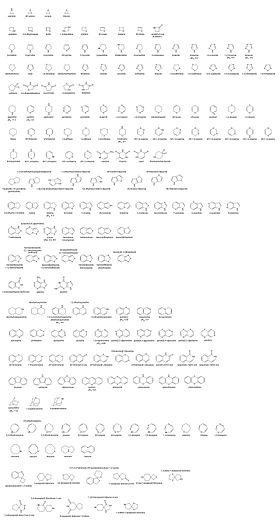
Back مركب حلقي غير متجانس Arabic Heterotsiklik birləşmələr Azerbaijani Гетэрацыклічныя злучэнні Byelorussian Хетероциклично съединение Bulgarian বিষমচাক্রিক যৌগ Bengali/Bangla Heterociklični spoj BS Compost heterocíclic Catalan Heterocyklické sloučeniny Czech Heterocyklisk forbindelse Danish Heterocyclen German


A heterocyclic compound or ring structure is a cyclic compound that has atoms of at least two different elements as members of its ring(s).[1] Heterocyclic organic chemistry is the branch of organic chemistry dealing with the synthesis, properties, and applications of organic heterocycles.[2]
Examples of heterocyclic compounds include all of the nucleic acids, the majority of drugs, most biomass (cellulose and related materials), and many natural and synthetic dyes. More than half of known compounds are heterocycles.[3] 59% of US FDA-approved drugs contain nitrogen heterocycles.[4]
- ^ IUPAC Gold Book heterocyclic compounds
- ^ Cite error: The named reference
Gilchristwas invoked but never defined (see the help page). - ^ Rees, Charles W. (1992). "Polysulfur-Nitrogen Heterocyclic Chemistry". Journal of Heterocyclic Chemistry. 29 (3): 639–651. doi:10.1002/jhet.5570290306.
- ^ Edon Vitaku, David T. Smith, Jon T. Njardarson (2014). "Analysis of the Structural Diversity, Substitution Patterns, and Frequency of Nitrogen Heterocycles among U.S. FDA Approved Pharmaceuticals". J. Med. Chem. 57 (24): 10257–10274. doi:10.1021/jm501100b. PMID 25255204.
{{cite journal}}: CS1 maint: multiple names: authors list (link)
© MMXXIII Rich X Search. We shall prevail. All rights reserved. Rich X Search